The Impact of Armed Conflict on Women and Girls - UNFPA
The Impact of Armed Conflict on Women and Girls - UNFPA
The Impact of Armed Conflict on Women and Girls - UNFPA
Create successful ePaper yourself
Turn your PDF publications into a flip-book with our unique Google optimized e-Paper software.
Target Groups<br />
<strong>Women</strong><br />
<strong>Women</strong> <strong>and</strong> children make up four fifths <str<strong>on</strong>g>of</str<strong>on</strong>g> the world’s refugees <strong>and</strong><br />
internally displaced people. Yet, <strong>on</strong>ly recently has attenti<strong>on</strong> been focused <strong>on</strong> the<br />
particular needs <strong>and</strong> circumstances <str<strong>on</strong>g>of</str<strong>on</strong>g> women refugees.<br />
<strong>Women</strong> play a key role in ec<strong>on</strong>omic, social <strong>and</strong> family life. <strong>Women</strong> are<br />
most affected by reproductive health problems. For refugee women, who <str<strong>on</strong>g>of</str<strong>on</strong>g>ten<br />
become sole heads <str<strong>on</strong>g>of</str<strong>on</strong>g> households, this burden is compounded by the<br />
precariousness <str<strong>on</strong>g>of</str<strong>on</strong>g> their situati<strong>on</strong>. It is imperative that a lack <str<strong>on</strong>g>of</str<strong>on</strong>g> comprehensive<br />
reproductive health services does not add to the suffering <str<strong>on</strong>g>of</str<strong>on</strong>g> refugee women.<br />
Investing in women’s reproductive health has a positive effect <strong>on</strong> the entire<br />
community, as women are <str<strong>on</strong>g>of</str<strong>on</strong>g>ten the sole carers for extended family units,<br />
including children <strong>and</strong> elders.<br />
People who are forced to flee are, for the most part, from countries with<br />
poor health <strong>and</strong> social indicators. <strong>Women</strong> <strong>and</strong> children are particularly adversely<br />
affected by forced migrati<strong>on</strong>; they face unique hardships during flight, including<br />
sexual violence <strong>and</strong> abuse. Once they eventually reach relative safety, they <str<strong>on</strong>g>of</str<strong>on</strong>g>ten<br />
face the lack <str<strong>on</strong>g>of</str<strong>on</strong>g> food, water <strong>and</strong> shelter; sickness <strong>and</strong> death; <strong>and</strong> the loss <str<strong>on</strong>g>of</str<strong>on</strong>g><br />
family <strong>and</strong> possessi<strong>on</strong>s.<br />
With c<strong>on</strong>flict comes loss <str<strong>on</strong>g>of</str<strong>on</strong>g> income, home, families <strong>and</strong> social support,<br />
depriving women <strong>and</strong> girls <str<strong>on</strong>g>of</str<strong>on</strong>g> security <strong>and</strong> income. As a c<strong>on</strong>sequence, they may<br />
be forced into transacti<strong>on</strong>al sex to secure their lives or those <str<strong>on</strong>g>of</str<strong>on</strong>g> their families,<br />
escape to safety or gain access to shelter or services, including the distributi<strong>on</strong> <str<strong>on</strong>g>of</str<strong>on</strong>g><br />
food <strong>and</strong> services.<br />
Young people<br />
Young people, whether female or male, are an especially underserved<br />
group within refugee populati<strong>on</strong>s. At a critical time in their development – the<br />
transiti<strong>on</strong> from childhood to adulthood – young refugees lose their role models;<br />
friends; family; their cultural <strong>and</strong> social system; <strong>and</strong> access to services, including<br />
training <strong>and</strong> educati<strong>on</strong> opportunities. It is important to ensure that reproductive<br />
health services meet the specific needs <str<strong>on</strong>g>of</str<strong>on</strong>g> younger <strong>and</strong> older adolescents, girls<br />
<strong>and</strong> boys.<br />
Young people, particularly young women, are at special risk during forced<br />
migrati<strong>on</strong>. Young people are at risk from abducti<strong>on</strong>, forced recruitment into<br />
armed forces, sexual violence <strong>and</strong> abuse <strong>and</strong> increased risk <str<strong>on</strong>g>of</str<strong>on</strong>g> STIs <strong>and</strong><br />
HIV/AIDS. Many are forced to head households <strong>and</strong> care for family members.<br />
<str<strong>on</strong>g>The</str<strong>on</strong>g>ir involvement in project planning <strong>and</strong> implementati<strong>on</strong> is key, <strong>and</strong> they are a<br />
vital part <str<strong>on</strong>g>of</str<strong>on</strong>g> rehabilitati<strong>on</strong> <strong>and</strong> rec<strong>on</strong>structi<strong>on</strong> programmes.<br />
45



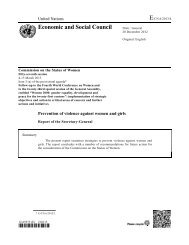
![IANSA [PDF, 2MB] - PeaceWomen](https://img.yumpu.com/25206379/1/190x123/iansa-pdf-2mb-peacewomen.jpg?quality=85)
![Commitments Sample [PDF, 93KB] - PeaceWomen](https://img.yumpu.com/25206331/1/190x245/commitments-sample-pdf-93kb-peacewomen.jpg?quality=85)


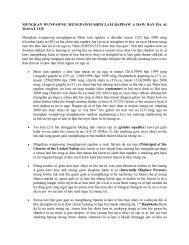
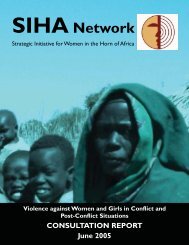

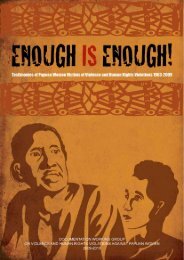

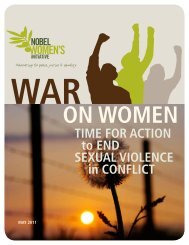
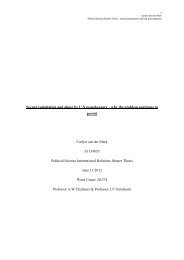

![A Toolkit for Advocacy and Action [PDF, 260KB] - Peace Women](https://img.yumpu.com/25205989/1/190x245/a-toolkit-for-advocacy-and-action-pdf-260kb-peace-women.jpg?quality=85)